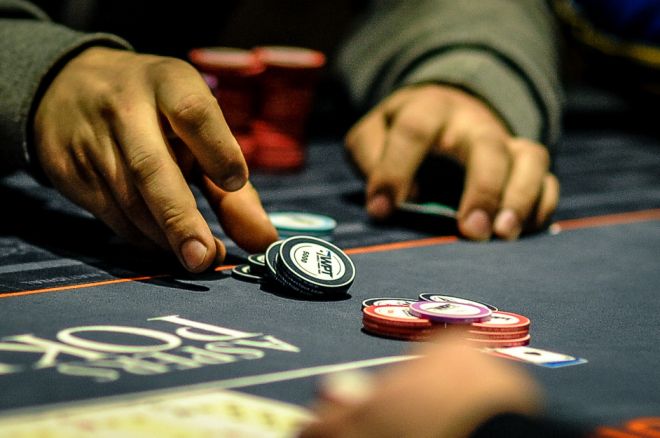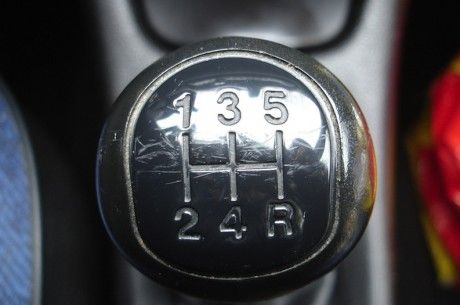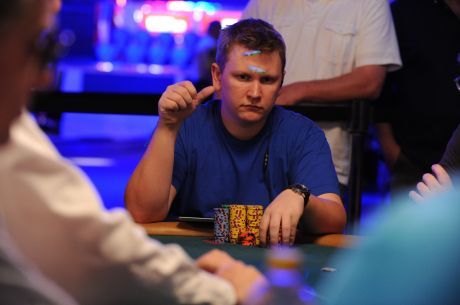When Betting Less Can Benefit More: The Blocking Bet

I occasionally play in a friend��s home poker game. It��s $0.10/$0.20 no-limit hold��em, $20 buy-in. With those stakes, I play more for fun, social contact, and to scratch the poker itch than to make any substantial money.
In a recent game, a situation came up in which I pulled out of the poker toolbox one of what is for me one of the less-often-used tools: the blocking bet. Also called a defensive bet, it will be old hat to experienced players, but may be unfamiliar to newer players, so I thought I��d expound a bit on how it functions and when it can be used.
Rather than start off with an abstract description of the circumstances in which a blocking bet is useful, let me tell you about the hand in which I deployed it.
I had A?Q? one seat off the button. Nearly everybody limped in ahead of me. I raised to $0.80. Four times the big blind is larger than conventional wisdom dictates, but I assure you that in this particular game, my opening raises are the wimpiest things going. Most people open to $1 or more, and one regular player is notorious for his raises to $5 �� 25 big blinds! As commonly happens in this ultra-loose game, I picked up five callers, making a pot of $4.80.
The flop was K?10?6?, giving me a gutshot draw to an ace-high straight, but nothing else. When the action was checked to me, I bet $2.40 �� half the pot. The only player to call was the button. He was the most experienced opponent I was facing that day. He would likely call there with any flush draw, any Kx, QxQx, JxJx, and any 10x. I think he would raise with any two-pair hand and any flopped set, not wanting to let me hit any draws cheaply.
The turn was the 2? �� a complete blank. I checked, intending to fold if he bet �� but he didn��t. His check virtually eliminated any remaining possibility that he had flopped two pair or three of a kind. It also eliminated any chance that he had just been floating me on the flop with nothing, because if that had been his plan, he would not pass up the opportunity to take the pot with a bet on fourth street.
The river was a simultaneous blessing and curse �� the J?. This miraculously turned my ace-high into a Broadway straight, but also completed flush draws. And that was the crux of the dilemma into which it put me. My hand was strong enough that if I checked, I would probably have to call just about any bet my opponent might make. At the same time, my hand was weak enough that I would lose to a flush a large percentage of the time.
My solution was to bet an amount smaller than my opponent would likely choose to bet �� either for value or as a bluff �� if I relinquished control of the hand by checking. I settled on $4, about 40% of the pot.
My opponent was observant enough to know that I have a wide preflop raising range from late position, which means that he would now have to assume that I could have anything from the stone-cold nuts to pure air. He��s probably going to feel obligated to call my bet with most of his one-pair hands, and with any two-pair hands that he happened to back into on the river. He will also call to split the pot if we both started with AxQx.
Most importantly, he will probably call �� not raise �� with any non-nut flush. This is because he will have to worry that I, too, was on a flush draw. With my preflop raise, I could easily have the ace-high flush, if he doesn��t have it.
There are essentially no hands with which he can bluff-raise here. So if he raises, I can with a high degree of confidence peg his hand as a high flush, and probably the nut flush. A fold is then both mandatory and easy.
The crucial concept is that my $4 river bet into a $10 pot is probably less than he would bet for value with any flush, and especially with the ace-high flush. Since I would feel obligated to call, with my straight as a bluff-catcher, my smaller lead-out bet accomplishes three things:
- It saves me money when he has a flush with which he would have bet a larger amount if I checked to him.
- It gets me value from his bluff-catcher calls (one-pair and two-pair hands) that I would miss if the action went check-check.
- It makes it difficult for him to raise with anything short of the nuts, thus giving me an easy fold if he does, in fact, submit a raise.
As it happened, he raised to $10, and there was no question that I had to fold.
You can see that the general circumstances for a blocking bet are:
- You��re out of position, usually in a heads-up situation.
- You have a marginal hand. ��Marginal�� is defined not on an absolute scale, but relative to your opponent��s likely range. In this particular hand, my opponent��s range was heavily weighted toward completed flush draws, against which a straight is indeed ��marginal.��
- The bet is relatively small. You��ll find some authorities specifying a fixed percentage of the pot, such as 10-25%. I think the more important feature, though, is that it be small compared to what you would expect your opponent to bet if you check.
The same concepts can be applied to turn bets, when you have a draw and want to see fifth street for a cheaper price than your opponent will likely charge if you leave the betting to him. But the bets that are clearly identified as blockers are most commonly made on the river.
For more on the topic �� including that idea of making a blocking bet when on a draw �� see ��Postflop Poker: Breaking Down the Blocking Bet.��
Robert Woolley lives in Asheville, NC. He spent several years in Las Vegas and chronicled his life in poker on the ��Poker Grump�� blog.
Get all the latest PokerNews updates on your social media outlets. Follow us on Twitter and find us on both Facebook and Google+!








